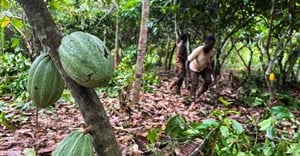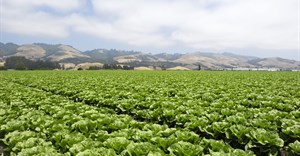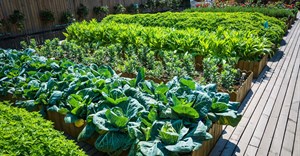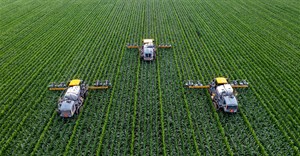A look at sustainable farming trends in South Africa
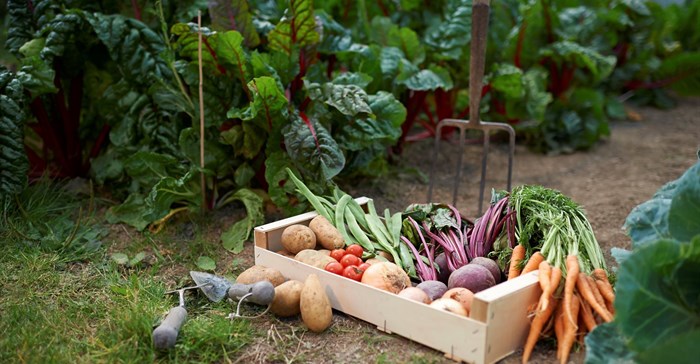
Over the years various production trends based on sustainable farming, have emerged in response to a myriad of agricultural challenges. These trends can help mitigate challenges such as climate change, water scarcity, soil degradation and feeding an ever-growing population.
In order to transition from one production method to another, it is important to understand the benefits, possible pitfalls, costs, yield potential and profitability of each option.
Organic farming
According to the Department of Environment, Forestry and Fisheries (DEFF), organic production refers to farming practices that do not use synthetic chemicals, which can include pesticides, fertilisers, fungicides, insecticides or genetically modified seeds.
Organic farming uses a range of techniques that support ecosystems, limit pollution and boost nutrition quality. Its practices can be applied to crop and animal production. Crop rotation, natural composting and organic pest control are implemented when crops are grown organically. Organic animal farming requires free-range animals that consume organic feed only.
According to DEFF, there are different views concerning the correct definition of organic farming. As a result, different farming practices have emerged under the umbrella term ‘organic farming’. These practices include:
• Biodynamic farming.
• Permaculture.
• Biological farming.
• Natural farming.
• Traditional farming.
Organic farming is becoming increasingly popular on a local and global scale and is considered to be one of the best agricultural models for emerging farmers. It is said to provide four times more nutrition and 32% more jobs per hectare than conventional agriculture.
Adopting organic practices
Despite its benefits, the organic farming sector is still plagued by market access and certification challenges, which hinders global market entry. Producers who are transitioning to organic practices are denied access to certified organic markets in developed countries for at least two to three years after having initiated the transition.
Organic farming is also known to cause decreased yields of between 20% and 40% in the first two to three years, compared to that of conventional agriculture. However, many small-scale farmers believe that pros such as reduced production costs and healthier soils, ecosystems and farmworkers outweigh the cons in the long run.
Adopting organic practices can be more challenging for commercial farmers. The yield gap between organic and chemically treated crops place producers under immense financial strain. Soil fertility should be addressed through biological farming before organic farming practices are implemented. Good soil practices effectively enhance nutrient availability, address pH problems and help to reduce the yield gap.
In South Africa, the adoption of organic farming practices has been low. In 2011, only 167 producers were certified to produce organic products, which equated to 127 106ha (0,04%) of all agricultural land. South Africa’s organic products are mainly exported and sold to the local market. These products include Rooibos tea, subtropical fruit, citrus, processed fruit, berries, vegetables, herbs and wine.
On a global scale, organic farming is gaining momentum. Australia, Argentina, China, Spain and the United States currently own the largest areas of organically cultivated agricultural land.
Farming practices for wine grapes
The Western Cape Department of Agriculture conducted research on organic and conventional vineyard production on the farm Vaalpan near Vredendal in South Africa. The study sheds light on the costs that can be expected during the first few years of organic farming. The farm constitutes 12ha, of which 3ha was used for the organic production of wine grapes.
At the time of the study, the farm had already been certified by SGS, formerly Société Générale de Surveillance, and was in its third year of organic wine production. The cultivars were already established as a planting of Shiraz (2ha) and a planting of Cabernet Sauvignon (1ha).
Table 1: Total conventional and organic costs per hectare for the farm Vaalpan in its third year of wine production.
| Type of cost | Conventional | Organic |
| Total farming costs | R12 437,27/ha | R23 848,22/ha |
| Provision for replacement | R6 345,00/ha | R3 322,00/ha |
| Establishment cost/ha/year | R1 586,32/ha | R1 587,48/ha |
| Total costs | R20 368,59/ha | R28 757,70/ha |
The risk analysis showed that the expected gross farm income was R52 287 and R58 782 for conventional wine grapes and organic wine grapes, respectively. The production of organic wine grapes was financially profitable because the gross margin was positive, and the existing production levels could recover the operational and total costs.
Profitable organic production can be attributed to reduced production costs brought on by self-made organic fertiliser, enhanced soil health and higher a selling price per bottle of organic wine when compared to conventionally made wine.
Conservation agriculture
Conservation agriculture comprises various reduced-tillage or no-till practices. These practices are all on a continuum with organic farming, with no-till being the most sustainable.
Conventional agriculture includes tillage, which can be defined as the preparation and cultivation of soil before and after planting. Reduced tillage allows soil disturbance of up to 20% to 25% through tine planters or a combination of tine and disc planters.
No-till practices do not allow any primary or secondary cultivation and require full vegetative cover. Minimum or reduced tillage allows only secondary cultivation and requires moderate vegetative cover. Conventional tillage allows both primary and secondary cultivation with little to no vegetative cover.
According to the Food and Agriculture Organization (FAO) of the United Nations, the modern plough is the main culprit behind land degradation. The average nutrient loss from soils in sub-Saharan African stands at 24kg/ha as a result of land degradation. This leaves soil vulnerable to erosion, water pollution and extreme climate conditions. It could also result in decreased crop yields. Tillage also exacerbates climate change, as it releases carbon into the atmosphere.
Reduced tillage can help to reduce fuel, capital outlay and labour expenses, replenish soil nutrients, and contribute to carbon sequestration, which leads to healthier, more compact soils. This results in higher-quality produce that can be sold for a higher profit.
Since conservation agriculture is based on a continuum of reduced or no-till practices, there is often little distinction between the degree of reduced tillage implemented when referring to conservation agriculture in South Africa. Instead, local producers consider the term ‘conservation agriculture’ as representative of both reduced-tillage and no-till practices.
As such, conservation agriculture in the broader spectrum is based on three principles:
• Minimal soil disturbance with no or reduced tillage.
• Permanent soil cover with a diverse selection of crops for crop rotation and cover crops.
• Continuous organic cover on soil using crop residues or living plants.
• Adopting conservation agriculture
Crops such as rice, soya bean, cotton, wheat, barley, chickpea, mustard and lentils are planted under conservation agriculture. In South Africa, approximately 15 to 20% of commercial farmers and only 5% of smallholder grain farmers have adopted conservation agriculture. However, the degree of adoption differs from province to province. The practice is gaining ground among grain producers, particularly among wheat farmers in the Western Cape.
Although an increase in conservation agriculture could mitigate climate change and ensure greater resilience for farming enterprises (which would ultimately increase crop yields), this production method still has its hurdles.
Some of the challenges include a lack of knowledge regarding conservation agriculture, policy implementation and new machinery or transition costs. Fully transitioning from conventional to conservation agriculture practices can take anything from five to seven years. Financial losses due to decreased yields during this time is one of the main concerns for both commercial and smallholder farmers.
A challenging transition
But while the transition may be challenging at first, greater yields later on compensate for the initial financial strain. Operating and fuel costs are also lower compared to conventional farming. Conservation agriculture also leads to greater predictability when it comes to production yields, healthier soil and reduced water and fertiliser requirements.
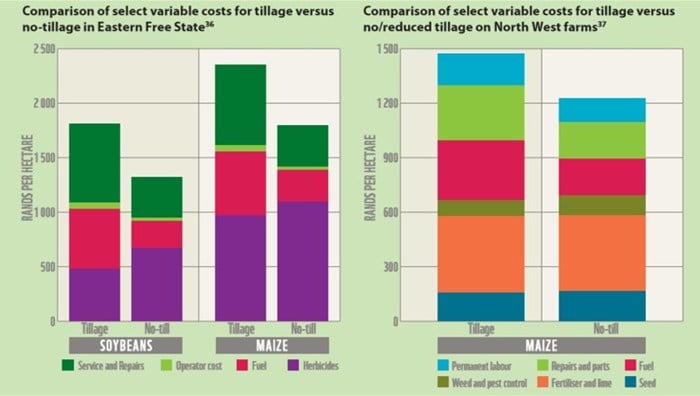
No-till requires less start-up capital compared to conventional farming practices. Average variable costs can be up to 12% lower for conservation agriculture compared to conventional agriculture in the North West and 10% lower in the Free State.
Table 2: Capital outlay, cultivation costs, number of hours and litres of fuel required per hectare for four tillage systems of maize. (Source: Department of Agriculture and Rural Development)
| Tillage system | Capital outlay (Rand) | Total costs per hectare (Rand) | Total hours per hectare | Total fuel per hectare (litre) | ||||
| Equipment | Labour | Equipment and labour | Agro-chemicals and nitrogen | Cultivation | ||||
| Conventional (disc, plough and disc) | R2 332 167 | R2 636,14 | R119,14 | R2 755,27 | R676,73 | R3 432,00 | 4,74 | 53,43ℓ |
| Chisel plough and disc | R2 368 797 | R2 414,08 | R109,25 | R2 523,33 | R676,73 | R3 200,06 | 4,22 | 46,6ℓ |
| Stubble mulch (chisel plough) | R2 228 067 | R1 876,44 | R86,45 | R1 962, 89 | R676,73 | R2 639, 62 | 3,02 | 30,83ℓ |
| No-till | R1 382 692 | R1 514,51 | R79,14 | R1 593, 65 | R1 617, 66 | R3 211,31 | 2,38 | 20,34ℓ |
Precision agriculture
Precision agriculture is generally referred to as ‘smart farming’ because it allows producers to supply crops with precise sustenance as and when needed. Inputs, which includes pesticides, water and fertiliser, are usually applied after sensor and positioning technology has supplied producers with crop data. This allows producers to analyse their crop fields and make informed decisions.
The driving forces behind the uptake of precision farming practices include rising input costs, strict export requirements, and the rapid evolution of technology, which makes new technology more affordable.
Smart monitoring is still relatively new in the South African market, but shows great promise. In the case of drones, the financial benefits outweigh the service costs when they are used on farms exceeding 40ha, and the same is true for satellite technology on farms exceeding 50ha.
Precision agriculture is usually implemented on high-value export crops and is exceptionally popular in the macadamia market. This practice is mostly driven by the need to reduce chemical use to ensure compliance with export markets and to manage water usage and input costs optimally.
However, all agricultural sectors may benefit from remote-sensing technology. The grain sector has seen a significant increase in crop yields because of precision agriculture practices. Accurate and more productive grain farm management results in reduced food deficits, which results in higher profitability and increased investment in high-value crops.
Table 3 shows the current market as captured by leading aerial data analytics company, Aerobotics, based on known data, as well as the estimated potential value of bespoke remote-sensing services.
Table 3: Estimated value of bespoke remote-sensing services in South Africa. (Source: GreenCape 2019)
| Commodity | Captured market (hectares) | Potential market (hectares) | Estimated value/season |
| Citrus | 14 546ha (20% of total production area) | 58 185ha | R34 million |
| Macadamia | 7 800ha (40% of total production area) | 11 700ha | R9,8 million |
| Wine grapes | No data | 94 545ha | R47 million |
| Table grapes | No data | 26 739ha | R13 million |
| Stone fruit | No data | 17 926ha | R9 million |
| Pome fruit | No data | 36 491ha | R18 million |
| Total | 22 346ha | 245 586ha | R131 million |
Barriers to the adoption of remote-sensing applications in precision agriculture include drone licencing, technology costs, limited funding, limited awareness of precision agriculture and a lack of technical knowledge. However, the potential savings per hectare can help to balance technological costs and bring about greater yields, which could help to finance new remote-sensing technology.
In 2018 the University of the Free State conducted a study of crop farming in the Schweizer-Reneke region of South Africa. According to the study, the majority of producers (94%) who adopted precision agriculture practices reported that problem areas and soil nutrient deficiencies were addressed more effectively. All producers who participated in the study agreed that the yield potential and actual yield increased significantly.
Producers who practise precision agriculture, concluded that it helps to improve productivity, lower production risks and reduce soil degradation. To them, precision agriculture is synonymous with sustainable agriculture. All the participants in the study who had adopted precision agriculture techniques, reported that it was economically viable and that expenses were recompensed within two years.
Table 4: Estimated costs for the implementation of precision agriculture in 2017. (Source: University of the Free State)
| Component | Cost |
| Physical mapping | R195/ha-1 |
| Chemical mapping | R195/ha-1 |
| Lime distributor and hydraulic motor | R202 500 |
| Fertiliser planter (two fertilisers) and hydraulic motor | R225 000 |
| Fertiliser planter (two fertilisers) and hydraulic motor | R262 500 |
| Control computer with a screen | R64 500 |
| Software | R18 000 |
| Base station for GPS | R63,000 |
| Real-time kinematic signal | R52 500 |
| Automatic steering for tractor | R120 000 |
Intensive and extensive farming
Intensive farming is a production system that maximises yield in a concentrated area. It usually involves major capital and labour inputs and is largely used for crop and animal farming. This method also uses fertilisers and machinery.
Extensive farming requires low capital and labour input in relation to the size of the farm and is usually implemented on larger farms of between 240 and 16,000ha. This method depends entirely on natural elements to produce a yield and does not use fertilisers or other external factors. Extensive farming is ideal for animal production, but can also be used for certain crops.
In South Africa, intensive crop production is usually implemented in the high summer and winter rainfall areas. It depends mainly on feed, pesticides, fertilisers, herbicides, irrigation, genetically modified seeds and fuel. In recent years, there has been an increase in intensive farming in sectors with high potential, particularly in the horticultural sector.
Most of South Africa’s land surface (69%) is suitable for grazing, which allows the livestock sector to thrive. Livestock farming is the largest agricultural sector in the country, with most cattle producers located in the eastern and north-western regions of the country. Sheep farming is prevalent in the central and western parts of the country.
Although most cattle and sheep farming enterprises use extensive farming, the dairy, pork and poultry sectors are farmed more intensively in major metropolitan market areas. There has been a market increase in intensive farming practices in the sheep production industry, as these systems allow for greater lamb yields, focused feed programmes and protection of the animals against predators and thieves.
The semi-arid southern and western interior of South Africa is suitable for extensive livestock production. Game farming mostly occurs in the Eastern Cape, particularly in the Karoo and uses extensive farming practices, although intensive practices such as the feeding of game in camps have been gaining popularity.
A significant global increase in intensive cattle production, which can be attributed to the growing population and increasing demand for protein, has been noted in the last decade. Global warming is also expected to put more pressure on extensive farming systems, which could lead to increased adoption of intensive livestock production. Feedlots are commonplace and have become a major provider of meat. Feedlots for small stock such as sheep is also being adopted at a fast rate.
Source: AgriOrbit

AgriOrbit is a product of Centurion-based agricultural magazine publisher Plaas Media. Plaas Media is an independent agricultural media house. It is the only South African agricultural media house to offer a true 360-degree media offering to role-players in agriculture. Its entire portfolio is based on sound content of a scientific and semi-scientific nature.
Go to: http://agriorbit.com/







